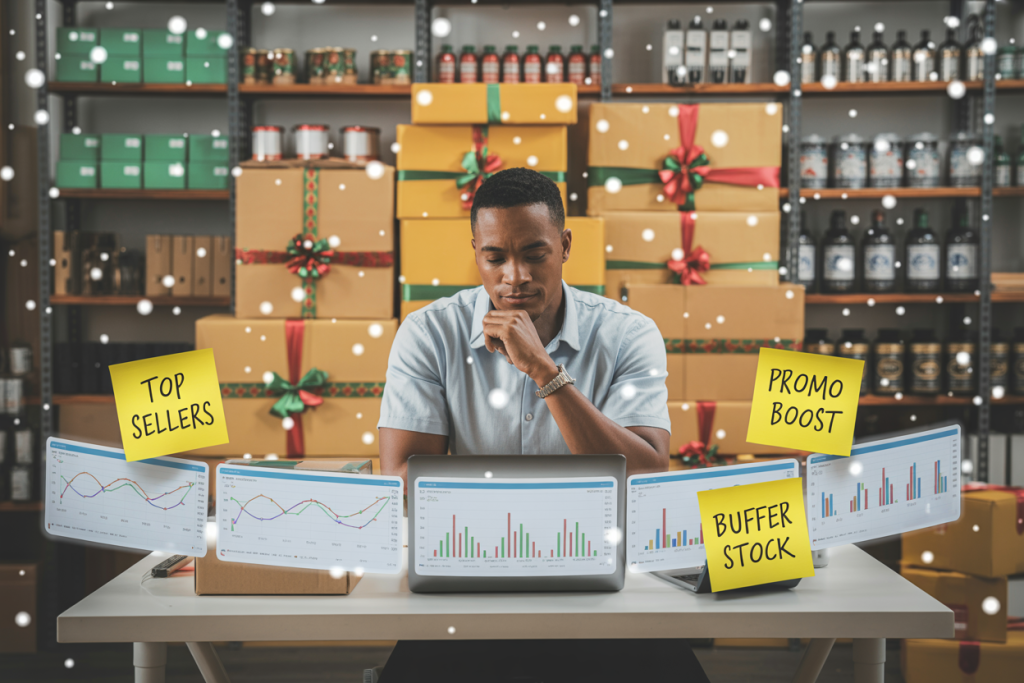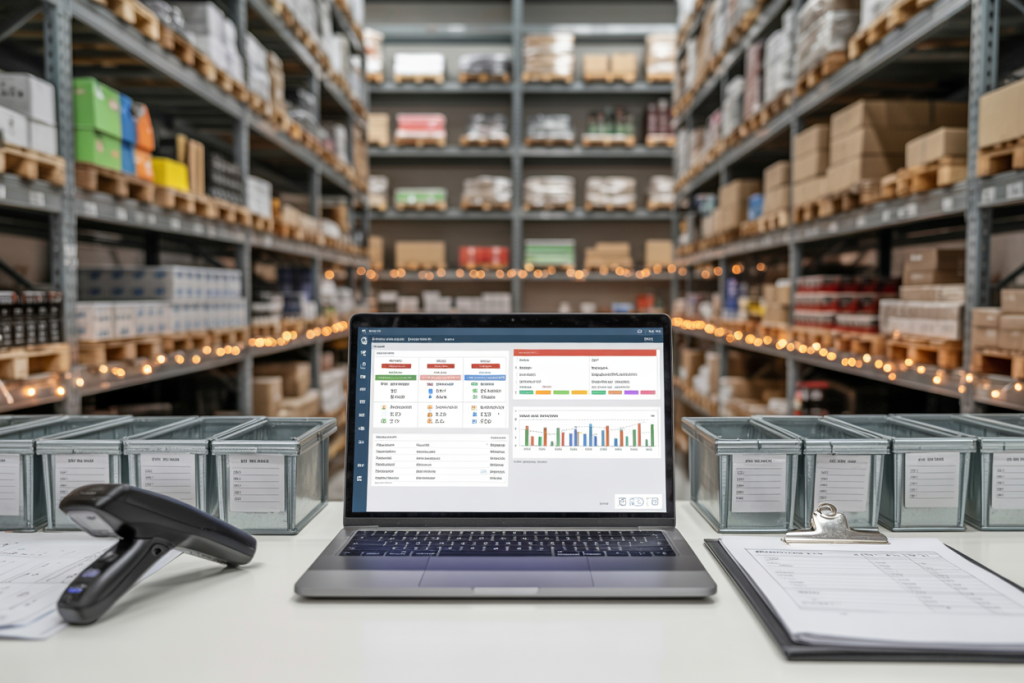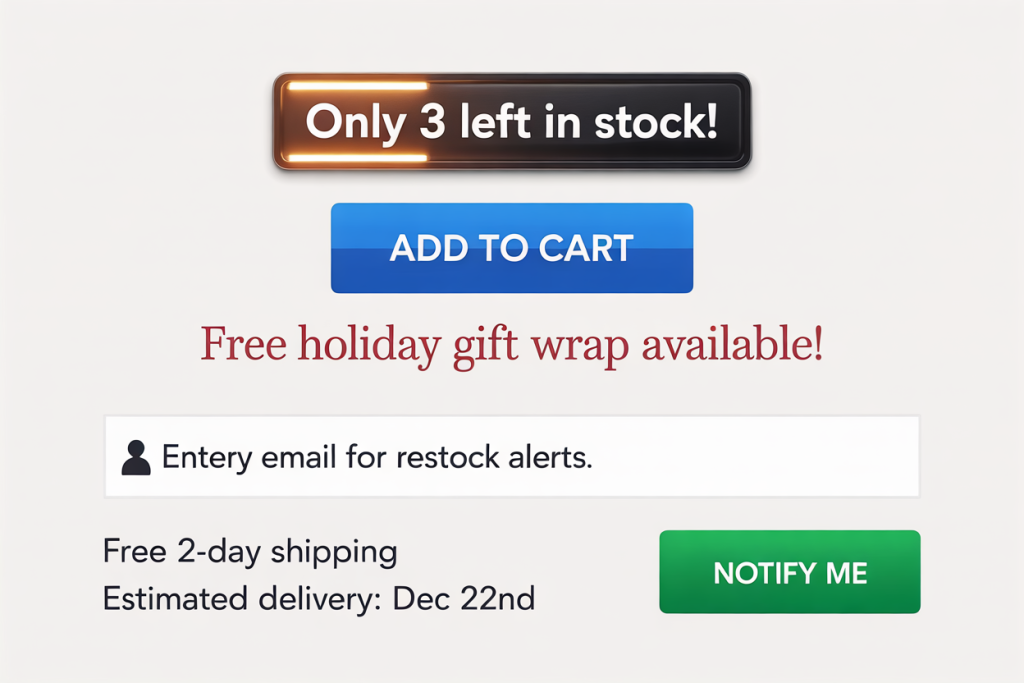
It’s Black Friday. Your traffic is surging. Your ads are crushing it. And then—bam—your best-selling item runs out of stock. Cue the angry emails, refund requests, and your conversion rate doing a sad little nosedive.
Let’s be real: Shopify inventory optimization isn’t just a “nice-to-have” during Q4. It’s survival. And done right, it’s also one of the most powerful levers for turning browsers into buyers again and again through the holiday madness.
The Holiday Surge Is Not Hypothetical
Here’s what you’re up against:
- Your site traffic is about to quadruple.
- Customer expectations are at peak “Amazon Prime” levels.
- Your ad spend is going to feel like a burning stack of cash if your products aren’t in stock and ready to ship.
The holidays are retail’s Super Bowl—and inventory is your playbook. If you’re not actively optimizing it, you’re gambling with your margin and reputation.
The Shopify Inventory Nightmare Scenario
Every Shopify store owner has that one nightmare memory: the product that sold out mid-campaign, the ad you couldn’t shut off fast enough, the flood of “where’s my order?” DMs that made you question your life choices.
You don’t have time for that in Q4.
Inventory issues can snowball fast:
- Bestsellers sell out → cart abandonment goes up.
- Customers bounce → your CPA skyrockets.
- Fulfillment delays → refund requests & churn.
- Repeat customers? Not this year.
But it’s avoidable—with the right inventory strategy in place.

Shopify Inventory Optimization = Sales Insurance
Smart inventory optimization gives you what you really want:
- Confidence to spend big on holiday ads
- Peace of mind knowing you won’t oversell
- Flexibility to pivot if trends shift mid-sale
- Happy customers who actually get their stuff on time
And here’s the kicker: customers don’t see “we ran out” as a technical glitch. They see it as a broken promise. In their minds, if you couldn’t deliver during the holidays, how can they trust you the rest of the year?
This is how inventory affects lifetime value—not just the short-term sale.
The Q4 Fulfillment Equation: More Than Just Stock Levels
Let’s be clear—inventory optimization isn’t just “do we have enough stuff in boxes?” It’s:
- Do we have enough of the right stuff?
- Can we fulfill and ship it fast?
- Are we clearly communicating availability and expectations on every page?
You’re not just selling products. You’re selling trust. And nothing breaks trust faster than a “Sorry, this item is backordered ’til January” email three days before Christmas.
Real Talk: The Supply Chain Isn’t Your Friend
Even in 2025, supply chain hiccups are a reality. Whether it’s a delayed supplier in Shenzhen or a surprise UPS surcharge, any weak link in your fulfillment flow becomes your problem—and your customer’s disappointment.
Which means the sooner you start planning your Q4 inventory strategy, the more runway you give yourself to adjust and adapt.
Forecasting Demand with Data
If you’re still “going with your gut” on holiday product demand, you might as well be selling beepers and fax machines. Because in Q4, Shopify inventory optimization requires precision, not vibes.
Smart inventory starts with smart forecasting, and that means opening up your data toolbox—not a crystal ball. Here’s how to do it like the e-commerce boss you are (or will soon be).
Look Back Before You Leap Forward
Past sales aren’t just dusty numbers in a spreadsheet—they’re predictive gold. Pull up last year’s November and December stats and ask:
- Which SKUs moved fastest?
- What stalled like a Blockbuster membership in 2009?
- Were there any surprise sleeper hits?

Use Shopify’s sales reports or plug into tools like Inventory Planner to identify historical trends. And if 2024 was your first year? Use industry benchmarks (yes, we can help with that) to make smart assumptions.
Zoom In on Top-Sellers
Once you’ve got the macro view, it’s time to go micro. Rank products by revenue and units sold during previous peak seasons. Then dig into:
- Product margin: Don’t just stock what sells—stock what profits.
- Availability from suppliers: That trendy product might be in demand, but if your supplier needs six weeks and a unicorn to ship it… pass.
- Complementary items: What tends to be bought together? Bundle prep starts here.
This isn’t just good planning. It’s pre-emptive domination.
Anticipate the Unexpected with Buffer Inventory
Here’s where you stop playing it safe and start planning like a pro. Holiday chaos is inevitable. Weather delays, supplier ghosting, shipping gridlock—it’s coming. So build buffer stock into your plan:
- For top 20% SKUs, consider a 20–30% stock buffer.
- Coordinate with suppliers to shorten reorder times.
- If cash flow’s tight, negotiate smaller but more frequent restocks.
This ensures you don’t run out just when TikTok makes your product viral.
Factor In Marketing Promotions
Don’t forecast in a vacuum. If you’re running a major BOGO on lip balm, your sales won’t look like last year’s. Align inventory with your promotion calendar:
- Flash sales? Pad stock 2–3x normal.
- Bundle promos? Forecast based on individual SKU velocity.
- Email drops? Expect a 10–30% spike in featured product demand.
Bottom line: treat marketing and inventory as a married couple. They succeed (or fail) together.
Track Pre-Holiday Behavior Now
Pro tip: your pre-holiday traffic tells a story before the sales even roll in.
- Monitor add-to-cart trends in September/October.
- Track email click-throughs to product pages.
- Watch for waitlist signups or back-in-stock notifications.
These soft signals = demand clues you can act on early. Shopify’s analytics or apps like Klaviyo + Hotjar can help you spot patterns before they snowball.
Avoid the “Gut Feeling” Trap
We get it. You’ve got instincts. But instincts don’t track shipping delays or supplier ghosting. Data does. A solid Shopify inventory optimization strategy replaces “I think this’ll sell” with “I know this will move—because it has, and here’s proof.”
In short: forecast with facts, stock for scale, and plan like your revenue depends on it… because it does.
Building an Inventory Plan for Holiday Promotions
Here’s the thing: holiday traffic without inventory planning is like hosting a party and forgetting the snacks. You’ve got a full house, but nothing to feed the frenzy.
Your Shopify inventory optimization strategy needs to align with the promotions you’re running—otherwise, you’re either overselling (cue the refunds and 1-star reviews) or stuck with a mountain of unsold gingerbread-scented socks in January.
Reserve High-Demand Stock
First rule of Q4: don’t run out of what people want most.
- Start with your bestsellers and hot seasonal items—those should be non-negotiable “guaranteed in stock” lines.
- Use Shopify’s product performance reports to identify your top performers over the last 90 days.
- For items featured in email campaigns or social promos, forecast 2–3x your usual volume (especially if there’s a discount or bundle offer involved).
Not every SKU needs deep inventory. But your heavy hitters? They deserve the VIP shelf space.
Coordinate with Suppliers — Like, Yesterday
If you haven’t already chatted with your suppliers, do it now. Holiday success hinges on timelines.
- Confirm lead times, even if you’ve ordered from them before. The holidays stretch everyone thin.
- Ask for order deadline cutoffs and schedule replenishment windows.
- For overseas suppliers, double-check shipping estimates—and always factor in customs delays.
Here’s a power move: negotiate split shipments. Half now, half later. That way, you’re not sitting on all the inventory up front (or crying into your cocoa when it’s delayed).
Map Stock to Promotions
Every offer you run—flash sale, bundle, free gift with purchase—should tie directly to stock.
- Creating a BOGO promo? Lock in extra inventory for the “get one” side.
- Offering tiered bundles? Forecast demand for every included SKU.
- Featuring a limited-edition product? Cap orders based on what you physically have (plus 5% fudge room for return mishaps or damage).
Pro tip: build promo bundles as virtual products in Shopify so you can track inventory without confusing your fulfillment team.
Avoid Deadstock Like Holiday Fruitcake
Here’s where some brands get tripped up. They over-order “just in case” and end up with a warehouse full of regrets.
Prevent this with a stock lifecycle plan:
- Label items as core, seasonal, or promotional.
- Assign each a “sell-through by” date. If it hasn’t moved by then, plan a markdown or last-chance push.
- Set an inventory exit strategy now, before you’re three eggnogs deep in December and can’t think clearly.
The goal is to sell out clean, not carry unsold sweaters into spring.
Factor in Return Volume
Yes, this is about selling—but smart inventory planning considers what comes back, too.
- Pad stock for popular sizes or SKUs that typically see returns (i.e., apparel).
- Forecast return volume based on last year’s rate (industry average is 10–30% during holiday spikes).
- Build a plan to re-integrate returns quickly so you can resell before the season ends.
Returns aren’t just a cost—they’re an opportunity. Treat them like inventory that hasn’t finished its story arc yet.

Shopify Tools for Smarter Inventory Management
You can have the best holiday promos in the world, but if your inventory system is held together by duct tape and crossed fingers, you’re one sale away from chaos.
That’s where the Shopify inventory optimization toolkit swoops in like the holiday hero it is.
Inventory Planner: Your Forecasting Crystal Ball
If “winging it” isn’t quite your holiday strategy (and it shouldn’t be), Inventory Planner is your new best friend.
- It predicts how much stock you’ll need, based on real-time sales trends, past performance, and lead times.
- You get purchase order suggestions that help you avoid both stockouts and overstock.
- Plus, it lets you build demand forecasts for bundles, not just individual SKUs.
Translation: no more Excel wizardry or back-of-the-napkin guesswork.
Stocky: Built for Shopify POS and Multi-Location Brands
For Shopify users running in-person + online stores, Stocky is a native app that keeps everything in sync.
- It tracks stock across locations, so your online store doesn’t oversell what’s already been bagged in-store.
- Generates low-stock alerts and auto-recommendations.
- Integrates with Shopify POS and shows profit margins per item, so you can prioritize stocking what actually sells.
Basically, Stocky keeps you stocked without the stock panic.
Third-Party Warehouse Integrations: The Fulfillment Force Multiplier
If you’re using 3PLs or external warehouses, your inventory system needs to talk to them in fluent API.
Good news: Shopify plays nice with just about everyone.
- Use integrations like ShipBob, Deliverr, or Ware2Go to sync inventory in real time.
- Make sure all channels update simultaneously — no more “Available” on your site when it’s been gone for a week.
- Set inventory buffer thresholds to avoid selling beyond your limits.
And hey, even if you’re still shipping from your garage, these integrations can prep you to scale fast — because a killer Q4 can turn side hustle into full-time gig overnight.
Bonus Tools Worth a Look
Want to really flex those inventory muscles? Layer on tools that give you more visibility and control:
- SkuVault: Great for barcode scanning and multi-warehouse fulfillment.
- Katana: Especially helpful for DTC brands who also manufacture in-house (hello, makers).
- ReStock Alerts: Lets customers sign up for restock notifications — boosts conversions and builds urgency.
Remember: you don’t need all the tools. Just the right combo for your fulfillment flow.
Choosing the Right Stack
Here’s the deal: don’t install six apps just because you can.
- Start with your goals — speed, visibility, automation — and choose tools that support those outcomes.
- Test them before Q4. Nothing’s worse than launching your Black Friday deal and realizing your inventory tool “forgot” to sync your bestsellers.
- Train your team. Even the slickest tech flops if no one knows how to use it.
Smart inventory tools give you the confidence to run bold campaigns, knowing your backend can actually keep up with your front-end fireworks.

Preparing Your Fulfillment for Speed and Scale
You’ve got products. You’ve got promos. Now you just need to make sure your fulfillment doesn’t collapse like a gingerbread house in a heatwave.
Shopify inventory optimization doesn’t stop at keeping stock levels healthy — it’s also about getting products out the door faster than you can say “Black Friday meltdown.”
Here’s how to get fulfillment-ready before the Q4 stampede kicks in.
✅ Confirm Your Shipping Carriers…Like, Yesterday
You don’t want to find out that your go-to carrier is mysteriously overwhelmed two days before your biggest sale.
- Get written confirmations of pickup schedules from your carriers.
- Ask about holiday delivery cutoffs (yes, they change during peak season).
- If your main carrier fails you, have a backup ready — maybe one that rhymes with “SchmeDEx.”
Bonus: Shopify Shipping already lets you compare rates and timelines across major carriers right in your dashboard. Use that. It’s not just for decoration.
✅ Pre-Pack Like a Pro
Look, fulfillment chaos is 90% poor prep and 10% “oops, we didn’t see that coming.”
Start boxing bestsellers now — like you’re gift-wrapping success.
- Pre-pack your top-selling SKUs in standard sizes.
- Use color-coded labels for bundles, promo items, and VIP orders.
- Set up staging zones for quick grabs during the rush.
Not only does this save time, it helps your fulfillment team feel like Navy SEALs instead of headless chickens.
✅ Don’t Sleep on Packaging Supplies
Imagine this: it’s Cyber Monday. You’ve sold out your new “Warm & Fuzzy” holiday bundle — and then realize you’re out of shipping boxes.
Avoid this horror story:
- Order your supplies early — boxes, tape, inserts, bubble wrap.
- Print thank-you cards or promo flyers in bulk now.
- Don’t forget holiday branding — even a red tissue paper goes a long way in creating a moment.
Pro tip: personalized unboxing experiences are an underrated secret weapon. Give customers a reason to share it.
✅ Map Out a Backup Fulfillment Plan
Hope for the best. Plan for the carrier strike. Or the flu outbreak. Or the warehouse gremlins.
Create a fulfillment contingency plan:
- Have temporary help (family, part-time packers, college interns with ambition).
- Set up Shopify location rules so orders can reroute to other fulfillment partners.
- Prepare “rain check” automations: if an item is delayed, trigger an email explaining the situation + offer a freebie or discount for the wait.
Even if you never need it, this plan = peace of mind. And less crying into your inventory reports at midnight.
✅ Communicate Shipping Expectations Early
One of the best customer retention hacks is clarity.
Tell your customers:
- When they should expect delays (and what you’re doing to prevent them)
- What the last day for guaranteed holiday delivery is
- Where they can check order status (bonus points if you use branded tracking pages)
This builds trust. And trust builds returning buyers.
Communicating Inventory Status to Customers
If your customer has to guess whether that hot holiday item is in stock, you’ve already lost them. In Q4, clarity is conversion. Communicating inventory status is one of the most overlooked — yet powerful — elements of Shopify inventory optimization.
This isn’t about flashing “Sold Out” in neon red. This is about guiding the shopper journey with confidence, transparency, and just the right dose of FOMO.
Here’s how to make communication your secret sales weapon.
✅ Real-Time Stock Counters That Convert
You’ve seen ‘em: “Only 3 left in stock.” Suddenly, your shopper’s casual curiosity becomes frantic need.
Use these ethically and effectively:
- Add low-stock alerts to product pages (“Only 5 left!”).
- Show inventory thresholds on bundle deals.
- Use urgency bars like “Selling Fast!” or “Almost Gone!”
Shopify apps like While Supplies Last, Stocky, or Vitals make this plug-and-play simple.
But beware: fake scarcity will backfire. Use this tactic only when it’s real — and it works beautifully when it is.
✅ Restock Notifications: A Simple Email Goldmine
Sold out? Don’t say “tough luck.” Say “we got you.”
Activate back-in-stock alerts:
- Allow customers to sign up for restock emails or SMS.
- Trigger automatic messages when inventory refreshes.
- Bonus: capture interest → build your waitlist → gauge demand.
It’s like catching the fish after it swam off… but with email automation instead of bait.
Apps like Back in Stock, Notify Me!, and Klaviyo flows handle this like pros.
✅ Set Clear Expectations (Before They Ask)
No one likes guessing. So don’t make them.
Let your customers know:
- When the item ships (estimated processing + delivery times)
- How many are left (if low inventory is relevant)
- What happens next (confirmation, tracking, support)
Best spots to communicate this:
- Right on the product page
- In the cart drawer
- Inside your confirmation emails
Pro tip: add a mini FAQ in the product description during BFCM — it’ll cut down support tickets and boost conversion clarity.
✅ Turn “Out of Stock” into Opportunity
You don’t need a warehouse full of every SKU to win Q4.
Here’s what to do when a product is sold out:
- Suggest alternatives: “Looking for something similar?”
- Offer pre-order or backorder (if restock is imminent)
- Capture their email for restock alerts or wishlist
This keeps your store from becoming a dead end. And it shows you care — which is how you turn browsers into subscribers, and subscribers into customers.
✅ Use Language That Builds Trust (Not Friction)
If you’re delivering shipping updates, out-of-stock messages, or delay notifications — the tone matters.
Use clear, kind language:
- “Heads up — this item ships a little slower during the holidays. But we promise it’s worth the wait.”
- “This one’s popular! Sign up to be the first to know when it’s back.”
- “Order now to make the delivery cut-off!”
Your tone should sound like your brand — helpful, human, and zero panic.

Let’s face it — Shopify inventory optimization during the holidays can feel like juggling flaming swords while riding a unicycle… blindfolded… in traffic.
You’ve got fluctuating demand, chaotic fulfillment partners, delayed suppliers, and customers with the patience of a caffeinated squirrel.
That’s where Cirius Marketing swoops in like your Q4 inventory sidekick — minus the cape, plus a whole lot of data-backed strategies.
Here’s what we help with — and how we keep your virtual shelves stocked and selling.
✅ Inventory Forecasting That’s Actually Useful
Forecasting isn’t about crossing your fingers and whispering sweet nothings to last year’s sales reports.
We dig into:
- Sales velocity per product
- Seasonality curves by category
- Promotions and campaign influence on demand
Then we help you build a reality-based projection model — one that prepares you for the rush without overstocking like it’s a Costco panic run.
Bonus: Our system flags SKUs with weak sell-through, so you don’t reorder duds.
✅ Promotion-Aligned Inventory Planning
Got a killer BFCM bundle coming?
We align your offer strategy with your stock strategy — so you never run a promo you can’t fulfill.
What we help you plan for:
- Bundle readiness: Do you have enough of each product?
- Top product buffers: How many units do you need at scale?
- Restock windows: Can your suppliers deliver mid-campaign?
Because nothing crushes conversions faster than a “Sold Out” banner… on your best seller… two days into Cyber Week.
✅ Full Funnel Inventory Integration
Inventory isn’t just a warehouse problem — it’s a marketing problem too.
We make sure your campaigns, emails, ads, and pages all know what’s actually available and adjust in real time.
How?
- Real-time data syncs with Shopify + fulfillment tools
- Dynamic creative swaps if a product goes out of stock
- Segment-based flows for in-stock vs. waitlist customers
So your holiday funnel isn’t just firing — it’s agile, accurate, and responsive. Like an espresso-fueled customer service agent with a sixth sense for product availability.
✅ Your Backup Plan for the Unexpected
Even with planning, holiday chaos happens. Shipping bottlenecks. Supplier mix-ups. A TikTok influencer blows up your SKU overnight.
We help you prep a Plan B (and C):
- Alternate fulfillment partners on standby
- Pre-order campaign templates
- Messaging toolkits for delayed orders or high demand
The goal: turn unexpected stock stress into an opportunity to impress.
✅ Transparent Reporting That Doesn’t Require a Decoder Ring
You’ll know exactly:
- Which SKUs are moving
What bundles are over- or underperforming - How inventory levels are affecting sales velocity
No jargon. No spreadsheets from hell. Just plain-English dashboards and strategy calls that help you stay ahead.

Leave a Reply
You must be logged in to post a comment.